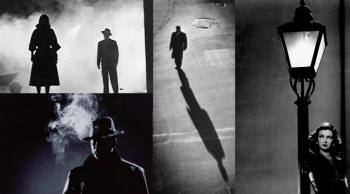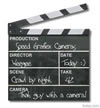Film Noir
 Literally "Black Film" film noir was a
mood, a style, a tone...The classic period of Film Noir was from the
early 1940s to 1960.
Literally "Black Film" film noir was a
mood, a style, a tone...The classic period of Film Noir was from the
early 1940s to 1960.
The phrase Film Noir was coined by French critics.
It referred primarily to the look of the films which emphasized
strong contrast and heavy use of shadows. All "true" noirs are
black and white. Scenes are often shot at night. The films often portray visual distortion and disorientation.
In a sense, Film Noir is a truly American art form. It deals with settings, situations,
and characters that are (for the most part) distinctly American.
However, in many ways Film Noir is
the American version of German Expressionism. Many of the key
figures in Film Noir were Germans who had fled the rise of Hitler.
These included Fritz Lang, Otto Preminger, Billy Wilder, and
numerous others.
Next: Characteristics of film noir
 One of the other key inspirations for Film Noir was Weegee. Weegee was the pseudonym of Arthur Fellig (1899-1968), arguably the greatest photojournalist of the 1930s and 1940s. Weegee, an immigrant from Ukraine (then Austrian Galicia) roamed New York City with a Speed Graflex camera taking pictures of mobsters, murders, car crashes and cafes. He worked largely at night. His photos were published in most of the New York City tabloid papers of the era. Weegee was one of the first civilians to have a police radio receiver. As a result, he was often among the first on the scene of shootings and other crimes. When asked about his photographic technique, he famously replied "F/8 and be there" (f/8 is a lens aperture measurement). Weegee claimed that his name came from Ouiji board and referred to his almost prescient ability to be at the scene of a crime. This was probably untrue: the name most likely came from his earlier position as a squeegee boy, a kid who dried prints and ran errands in a commercial photo production darkroom (in his case, Acme Newspictures). Weegee was a strong self promoter, signing his photos with a stamp that read "Weegee the Famous." His 1945 book Naked City collected many of his best photos and was hugely influential. A 1948 noir film was also called Naked City. The producer bought the title from Weegee but the film had nothing directly to do with him. Weegee, however, was the inspiration for a different film, Dan Gilroy's 2014 Nightcrawler, about a creepy crime scene photographer. You can see some general Weegee pictures at this link and shots he took of murder victims at this link (both are optional. The second is pretty graphic).
One of the other key inspirations for Film Noir was Weegee. Weegee was the pseudonym of Arthur Fellig (1899-1968), arguably the greatest photojournalist of the 1930s and 1940s. Weegee, an immigrant from Ukraine (then Austrian Galicia) roamed New York City with a Speed Graflex camera taking pictures of mobsters, murders, car crashes and cafes. He worked largely at night. His photos were published in most of the New York City tabloid papers of the era. Weegee was one of the first civilians to have a police radio receiver. As a result, he was often among the first on the scene of shootings and other crimes. When asked about his photographic technique, he famously replied "F/8 and be there" (f/8 is a lens aperture measurement). Weegee claimed that his name came from Ouiji board and referred to his almost prescient ability to be at the scene of a crime. This was probably untrue: the name most likely came from his earlier position as a squeegee boy, a kid who dried prints and ran errands in a commercial photo production darkroom (in his case, Acme Newspictures). Weegee was a strong self promoter, signing his photos with a stamp that read "Weegee the Famous." His 1945 book Naked City collected many of his best photos and was hugely influential. A 1948 noir film was also called Naked City. The producer bought the title from Weegee but the film had nothing directly to do with him. Weegee, however, was the inspiration for a different film, Dan Gilroy's 2014 Nightcrawler, about a creepy crime scene photographer. You can see some general Weegee pictures at this link and shots he took of murder victims at this link (both are optional. The second is pretty graphic).
 For the more hard core photography fans among you, here's a picture of a Speed Graphic or Graflex camera:
For the more hard core photography fans among you, here's a picture of a Speed Graphic or Graflex camera:  You'll probably recognize it from old movies and press photos. These cameras go back to the early years of the 20th century but were most famous for their use in the 1930s, 1940s and 1950s. They were produced up until the early 1970s. They were "speed" because the shutter time could be as fast as 1/1000 of a second. Because of this they could capture even very fast action. The cameras could be used either hand-held or mounted on a tripod. They had different viewfinders for the different ways of using them. Although the cameras were available in a variety of formats, the most common was 4x5. The numbers refer to the size of the negative; in this case, four inches by five inches. Weegee said he always used a 4x5 Speed Graphic with a Kodak Ektar Lens. A large blinding flash could be attached to the camera. The flash used a single use bulb (use of the "flash powder" you sometimes see in movies ended around 1930). 4x5 film was difficult to work with. Usually it was used on changeable plates that held two shots, one on each side, though some systems that held more were available. The advantage was that a 4x5 negative is the same size as fifteen 35mm negatives. That means that the resolution can be absolutely incredible. The Speed Graflex had another advantage as well. According to Weegee: "If you are puzzled about the kind of camera to buy, get a Speed Graphic... for two reasons... it is a good camera, and moreover... with a camera like that the cops will assume that you belong on the scene and will let you get behind police lines."
You'll probably recognize it from old movies and press photos. These cameras go back to the early years of the 20th century but were most famous for their use in the 1930s, 1940s and 1950s. They were produced up until the early 1970s. They were "speed" because the shutter time could be as fast as 1/1000 of a second. Because of this they could capture even very fast action. The cameras could be used either hand-held or mounted on a tripod. They had different viewfinders for the different ways of using them. Although the cameras were available in a variety of formats, the most common was 4x5. The numbers refer to the size of the negative; in this case, four inches by five inches. Weegee said he always used a 4x5 Speed Graphic with a Kodak Ektar Lens. A large blinding flash could be attached to the camera. The flash used a single use bulb (use of the "flash powder" you sometimes see in movies ended around 1930). 4x5 film was difficult to work with. Usually it was used on changeable plates that held two shots, one on each side, though some systems that held more were available. The advantage was that a 4x5 negative is the same size as fifteen 35mm negatives. That means that the resolution can be absolutely incredible. The Speed Graflex had another advantage as well. According to Weegee: "If you are puzzled about the kind of camera to buy, get a Speed Graphic... for two reasons... it is a good camera, and moreover... with a camera like that the cops will assume that you belong on the scene and will let you get behind police lines."
 Literally "Black Film" film noir was a
mood, a style, a tone...The classic period of Film Noir was from the
early 1940s to 1960.
Literally "Black Film" film noir was a
mood, a style, a tone...The classic period of Film Noir was from the
early 1940s to 1960. One of the other key inspirations for Film Noir was Weegee. Weegee was the pseudonym of Arthur Fellig (1899-1968), arguably the greatest photojournalist of the 1930s and 1940s. Weegee, an immigrant from Ukraine (then Austrian Galicia) roamed New York City with a Speed Graflex camera taking pictures of mobsters, murders, car crashes and cafes. He worked largely at night. His photos were published in most of the New York City tabloid papers of the era. Weegee was one of the first civilians to have a police radio receiver. As a result, he was often among the first on the scene of shootings and other crimes. When asked about his photographic technique, he famously replied "F/8 and be there" (f/8 is a lens aperture measurement). Weegee claimed that his name came from Ouiji board and referred to his almost prescient ability to be at the scene of a crime. This was probably untrue: the name most likely came from his earlier position as a squeegee boy, a kid who dried prints and ran errands in a commercial photo production darkroom (in his case, Acme Newspictures). Weegee was a strong self promoter, signing his photos with a stamp that read "Weegee the Famous." His 1945 book
One of the other key inspirations for Film Noir was Weegee. Weegee was the pseudonym of Arthur Fellig (1899-1968), arguably the greatest photojournalist of the 1930s and 1940s. Weegee, an immigrant from Ukraine (then Austrian Galicia) roamed New York City with a Speed Graflex camera taking pictures of mobsters, murders, car crashes and cafes. He worked largely at night. His photos were published in most of the New York City tabloid papers of the era. Weegee was one of the first civilians to have a police radio receiver. As a result, he was often among the first on the scene of shootings and other crimes. When asked about his photographic technique, he famously replied "F/8 and be there" (f/8 is a lens aperture measurement). Weegee claimed that his name came from Ouiji board and referred to his almost prescient ability to be at the scene of a crime. This was probably untrue: the name most likely came from his earlier position as a squeegee boy, a kid who dried prints and ran errands in a commercial photo production darkroom (in his case, Acme Newspictures). Weegee was a strong self promoter, signing his photos with a stamp that read "Weegee the Famous." His 1945 book  For the more hard core photography fans among you, here's a picture of a Speed Graphic or Graflex camera:
For the more hard core photography fans among you, here's a picture of a Speed Graphic or Graflex camera:  You'll probably recognize it from old movies and press photos. These cameras go back to the early years of the 20th century but were most famous for their use in the 1930s, 1940s and 1950s. They were produced up until the early 1970s. They were "speed" because the shutter time could be as fast as 1/1000 of a second. Because of this they could capture even very fast action. The cameras could be used either hand-held or mounted on a tripod. They had different viewfinders for the different ways of using them. Although the cameras were available in a variety of formats, the most common was 4x5. The numbers refer to the size of the negative; in this case, four inches by five inches. Weegee said he always used a 4x5 Speed Graphic with a Kodak Ektar Lens. A large blinding flash could be attached to the camera. The flash used a single use bulb (use of the "flash powder" you sometimes see in movies ended around 1930). 4x5 film was difficult to work with. Usually it was used on changeable plates that held two shots, one on each side, though some systems that held more were available. The advantage was that a 4x5 negative is the same size as fifteen 35mm negatives. That means that the resolution can be absolutely incredible. The Speed Graflex had another advantage as well. According to Weegee: "If you are puzzled about the kind of camera to buy, get a Speed Graphic... for two reasons... it is a good camera, and moreover... with a camera like that the cops will assume that you belong on the scene and will let you get behind police lines."
You'll probably recognize it from old movies and press photos. These cameras go back to the early years of the 20th century but were most famous for their use in the 1930s, 1940s and 1950s. They were produced up until the early 1970s. They were "speed" because the shutter time could be as fast as 1/1000 of a second. Because of this they could capture even very fast action. The cameras could be used either hand-held or mounted on a tripod. They had different viewfinders for the different ways of using them. Although the cameras were available in a variety of formats, the most common was 4x5. The numbers refer to the size of the negative; in this case, four inches by five inches. Weegee said he always used a 4x5 Speed Graphic with a Kodak Ektar Lens. A large blinding flash could be attached to the camera. The flash used a single use bulb (use of the "flash powder" you sometimes see in movies ended around 1930). 4x5 film was difficult to work with. Usually it was used on changeable plates that held two shots, one on each side, though some systems that held more were available. The advantage was that a 4x5 negative is the same size as fifteen 35mm negatives. That means that the resolution can be absolutely incredible. The Speed Graflex had another advantage as well. According to Weegee: "If you are puzzled about the kind of camera to buy, get a Speed Graphic... for two reasons... it is a good camera, and moreover... with a camera like that the cops will assume that you belong on the scene and will let you get behind police lines."